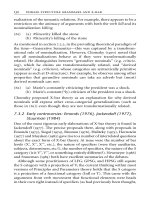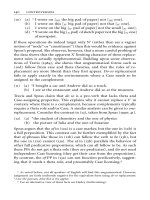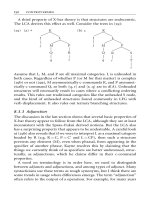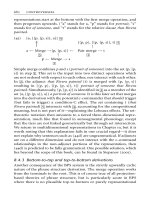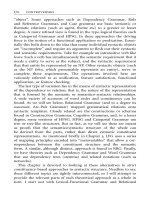Tài liệu Constituent Structure - Part 16 pptx
Bạn đang xem bản rút gọn của tài liệu. Xem và tải ngay bản đầy đủ của tài liệu tại đây (118.6 KB, 10 trang )
realization of the semantic relations. For example, there appears to be a
restriction on the animacy of arguments with both the verb kill and its
nominalization killing.
(61) (a) #Sincerity killed the stone
(b) #Sincerity’s killing of the stone
As mentioned in section 7.2.2, in the prevailing theoretical paradigm of
the time—Generative Semantics—this was captured by a transform-
ational rule of nominalization. However, Chomsky (1970) noted that
not all nominalizations behave as if they were transformationally
related. He distinguishes between ‘‘gerundive nominals’’ (e.g. criticiz-
ing), which he claims are transformationally related, and ‘‘derived
nominals’’ (e.g. criticism), whose categories are syntactically primitive
(appear as such at D-structure). For example, he observes among other
properties that gerundive nominals can take an adverb but (most)
derived nominals can not:
(62) (a) Marie’s constantly criticizing the president was a shock.
(b) Marie’s constant(*ly) criticism of the president was a shock.
Chomsky proposed X-bar theory as an explanation for why derived
nominals still express other cross-categorial generalizations (such as
those in (61)) even though they are not transformationally related.
7.3.2 Early controversies: Emonds (1976), Jackendoff (1977),
Stuurman (1984)
One of the most rigorous early elaborations of X-bar theory is found in
JackendoV (1977). The precise proposals there, along with proposals in
Emonds (1973), Siegal (1974), Bresnan (1976), Halitzky (1975), Hornstein
(1977)andMuysken(1982) gave rise to a number of interrelated questions
about the exact form of X-bar theory. At issue were the number of bar
levels (X’,X’’,X’’’, etc.), the nature of speciWers (were they auxiliaries,
subjects, determiners, etc.?), the number of speciWers, the nature of the S
category (is it V’’,V’’’, or something entirely diVerent?). Newmeyer (1986)
and Stuurman (1985) both have excellent summaries of the debates.
Although some practitioners of LFG, GPSG, and HPSG still equate
the S category with a projection of V, the current thinking within most
versions of Principles and Parameters theory holds that the S category
is a projection of a functional category (InX or T). This came with the
arguments from verb movement that functional elements were heads
in their own right instead of speciWers (as had previously been thought,
130 phrase structure grammars and x-bar
see for example Emonds 1985). More discussion of this can be found in
Chapter 11. This in turn opened up the possibility that speciWers were
uniquely linked to subjecthood (Stowell 1981).
The nature and number of projection types (X’,X’’,X’’’) was also an
early source of controversy. Chomsky’s original proposal didnot allow for
recursion at the X’ level. JackendoV’s version16 simply allowed an add-
itional prime for each additional layer of structure. Emonds (1976, 1973)
and the extensions in Stuurman (1986) had a fairly complicated system
that allowed for constituents to rewrite as a bar level equal to or lower than
the constituent’s own.17 The consensus in the more recent literature (see
e.g. Haegeman 2001) seems to roughly follow the proposal of Muysken
(1982)18 thatthere are only really three projection types:X8 (heads), whose
sister is the complement; iterative X’ categories, whose sisters are usually
adjuncts; and the XP whose sole non-head daughter is the speciWer.
Although there are many scholars who allow an exception, namely,
‘‘Chomsky Adjunction’’ (see Chametzky 2000 for extensive discussion),
where XP or X8 categories targeted by a movement operation can iterate,
thus creating additional speciWers (or head or adjunct) positions.
7.3.3 A major conceptual shift: metagrammar vs. grammar:
Stowell (1981)
Stowell’s (1981) dissertation caused an important conceptual shift in the
interpretation of what X-bar theory does. Prior to Stowell, the X-bar
principles were viewed metagrammatically; that is, X-bar theory was a
set of constraints on the formal properties of rules rather than on
linguistic forms (see e.g. Lightfoot 1979). Stowell proposed that instead
of constraining the form of phrase structure rules, X-bar theory should
be viewed directly as a constraint on structure.19 Other properties of
16 ‘‘X
n
! (C
1
)...(C
j
)X
nÀ1
(C
jþ1
)...(C
k
) where 1 # n # 3 and for all C
i
, either C
i
¼ Y’’’
for some lexical category Y or C
i
is a speciWed grammatical formative’’ (JackendoV 1977).
17 This has the interesting result that it allows for multiple speciWers, a proposal widely
adopted in the minimalism of the late 1990s in slightly diVerent guise.
18 Muysken’s actual proposal is that heads bear the features [Àproj, Àmax], intermedi-
ate projections are [þproj, Àmax], and phrases are [þproj, þmax]. There is a single rule:
X[þproj] ! ... X[Àmax] . . .
19 With the following properties:
(i) every phrase is endocentric;
(ii) speciWers appear at X’’ level, subcategorized elements appear within X’;
(iii) the head is adjacent to a constituent boundary;
(iv) the head term is one bar level lower than dominator;
(v) only maximal projections occur as non-heads.
x-bar theory 131
phrase structure rules (selectional requirements, etc.) are part of the
lexical information of the words participating in the relations.
Stowell summarizes his arguments for this conception in the following
paragraph:
The descriptive power of individual categorial rules is so strong that the
theory as a whole is unable to provide genuine explanations of the phenom-
ena that it has traditionally been supposed to account for. However, in some
domains the categorial formulae turn out to be largely redundant within the
overall structure of the grammar. Finally, for some languages, it seems that
there are serious problems in explicating how the categorial rules are induced
from the primary linguistic data, even given the constraints on X-bar
theory. (Stowell 1981: 61)
Kornai and Pullum (1990)20 oVer a reply to Stowell’s account. As noted
in Speas (1990), however, they seem to have misunderstood the basic
point of Stowell: the explanatory burden of PSGs can be shifted to
other parts of the grammar (such as the lexicon or licensing rules), and
what remains is the X-bar schema, which directly constrains constitu-
ent structure without speciWc phrase structure rules. This perspective is
common only in the Principles and Parameters approach, not in LFG,
GPSG, or HPSG.
7.4 Summary
The X-bar theory of phrase structure, whether it is construed as a
metagrammatical constraint or the actual mechanism of production of
constituency itself, provides us with a uniquely powerful tool for
describing the hierarchical structure of sentences. There are reasons
to think, however, that X-bar theory is too powerful. In the next
chapter, we consider work conducted between the late 1990s and the
early 2000s in the Chomskyan GB and Minimalist paradigms that
proposes constraints on X-bar theory, resulting in its eventual aban-
donment.
20 Building on Pullum (1984) and (1985).
132 phrase structure grammars and x-bar
Part 3
Controversies
This page intentionally left blank





